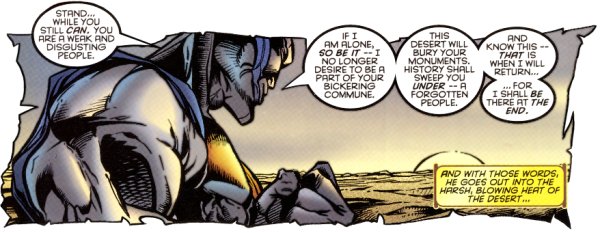Chapter II : En Sabah Nur; the First One
Ironically, the beginning of the story behind the being called Apocalypse did not begin in the distant past, but a thousand years hence. In the year 3000, the world had finally achieved the ultimate in civilization and culture. A glorious age of enlightenment and peace was enjoyed across the globe by all, save for one man. 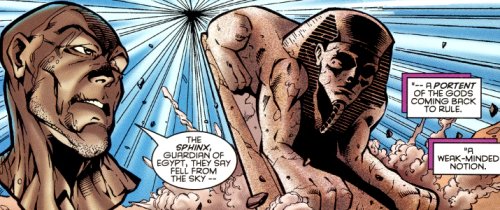
Arriving in 2950 BC during Egypt's second dynasty, the time traveler's arrival did not go unnoticed. Despite his meticulous plans, the traveler miscalculated some aspects of his journey and his time-Sphinx crash-landed violently, damaging it critically. 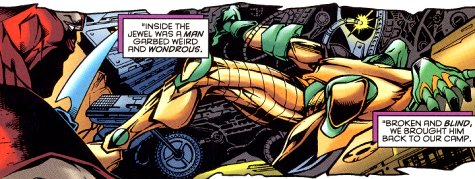
After weeks of healing, the man now known as Rama-Tut disappeared in the night with many of his weapons and equipment recovered from his craft; many, but not all. Mindful of the future, Baal had discovered several jewels recovered from Tut's craft and had secreted them away. In the few weeks after his disappearance, Tut managed to make his way to Egypt and, with his weapons from the future, conquer it single-handedly. Now made Pharaoh of Egypt, Rama-Tut returned to the Sandstormers' camp with the army of Egypt and demanded his lost jewels. When they refused, Tut massacred the tribe and enslaved most of the survivors. Ever the survivor himself, Baal and some of his kinsmen escaped with the jewels. Into one of these jewels, which he called the Eye of the Ages, Baal peered for answers, answers that he did indeed receive. While the Eye of the Ages did not tell Baal from where Tut had come, it did show him why he had come. Armed with this information, Baal decided not only to deny Tut his prize, but to acquire it himself and use it against the false Pharaoh.
Racing against the resources of the new Pharaoh, Baal's Sandstormers began a calculated but deadly search. Traveling from settlement to settlement, the Sandstormers slaughtered tribe after tribe in search of their prize. Having made their way across the Amentet, a region on the outskirts of what would eventually be known as the Valley of the Kings, the Sandstormers found a lone settlement called Akkaba. 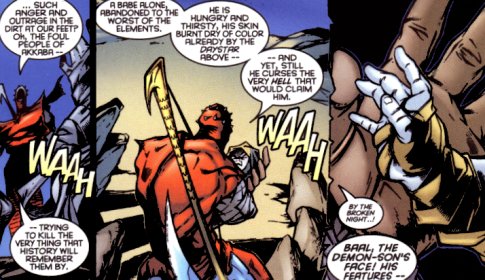 Like before, they slaughtered the populace and prepared to move on. Their departure was given pause when Baal heard the crying of a babe. Born with gray skin and an inhuman face, the former settlers of Akkaba had considered the child an abomination and cast it out. Building an altar of stones, the tribe had made it a sacrifice to the very nature its hideous birth defied. Likewise horrified by this infant, Baal's Sandstormers plead with him to leave the unnatural child to die. However, having found his prize, Baal refused and slaughtered those who questioned his wisdom. Where they saw a demon, he saw a god in the making.
Like before, they slaughtered the populace and prepared to move on. Their departure was given pause when Baal heard the crying of a babe. Born with gray skin and an inhuman face, the former settlers of Akkaba had considered the child an abomination and cast it out. Building an altar of stones, the tribe had made it a sacrifice to the very nature its hideous birth defied. Likewise horrified by this infant, Baal's Sandstormers plead with him to leave the unnatural child to die. However, having found his prize, Baal refused and slaughtered those who questioned his wisdom. Where they saw a demon, he saw a god in the making.


Chapter III : Evil, Given Purpose
As En Sabah Nur and his father attempted to connect meanings between the images from Tut's orb and Nur's existence, Ozymandias and his army had finally reached the Sandstormer camp two hundred feet above. With orders to recover only the youth known as En Sabah Nur, Ozymandias disobeyed his Pharaoh and ordered the slaughter of the Sandstormer camp. Initially finding the camp deserted, Ozymandias and his forces were ambushed by the hidden nomads and a deadly battle ensued. In the heat of the battle, the ground gave way beneath both sides, swallowing both whole. In the chamber far below, Nur, entranced by the Eye of the Ages, had taken it from its resting place. Whether by the whim of coincidence or through Nur's interruption of forces that they didn't understand, at that moment the ground had given way to the clashing forces above. The resulting cave-in had not only claimed almost all of the two forces above, but had buried Baal and En Sabah Nur alive.

Some time after the final passing of his adoptive father, En Sabah Nur finally found his way to the surface. There, to his surprise, he found Logos, the grand vizier to Rama-Tut waiting for him. Having been entrusted with a few of Rama-Tut's secrets, Logos suspected that Nur had survived. Now having found him, Logos offered Nur a deal. He would hide the last Sandstormer in exchange for him being his "engine of change." He would rid Egypt of the usurper Rama-Tut and the power mad general Ozymandias, who would drown the country with the blood of war. Still weary and needing time to rest, En Sabah Nur accepted and was hidden among the slaves working on the pyramid until he could regain his strength.
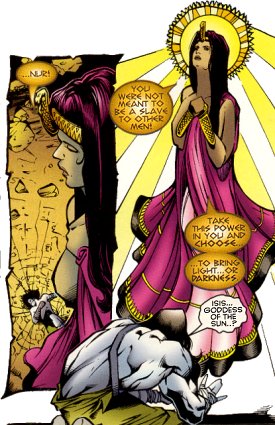
Into this already complicated mix of competing motives and ambitions arrived a team of players that took even the future cognizant Rama-Tut by surprise, the Fantastic Four. Arriving to the past by way of Doctor Doom's time machine, the foursome was searching for a possible cure for blindness hinted at in ancient hieroglyphs.  Using his "ultra diode ray," a weapon he had brought back from his time era, Rama-Tut sapped the Fantastic Four's free will and made them his servants. Tut's luck continued when he discovered Logos' deal with En Sabah Nur. With the help of Ozymandias' forces, Tut captured Nur, Logos and Nephri, whom he had decided to replace as his bride with the mind-controlled Susan Storm. Speaking to Nur before the assembled masses of his subjects, Rama-Tut offered Nur status as his heir. If he would swear loyalty, Tut promised, he would be given unparalleled secrets and would one day rule not just Egypt, but the world. Not surprisingly, En Sabah Nur refused and was immediately sentenced to die.
Using his "ultra diode ray," a weapon he had brought back from his time era, Rama-Tut sapped the Fantastic Four's free will and made them his servants. Tut's luck continued when he discovered Logos' deal with En Sabah Nur. With the help of Ozymandias' forces, Tut captured Nur, Logos and Nephri, whom he had decided to replace as his bride with the mind-controlled Susan Storm. Speaking to Nur before the assembled masses of his subjects, Rama-Tut offered Nur status as his heir. If he would swear loyalty, Tut promised, he would be given unparalleled secrets and would one day rule not just Egypt, but the world. Not surprisingly, En Sabah Nur refused and was immediately sentenced to die.
Still the survivor, Nur escaped his own execution and, with an ever-increasingly powerful body, returned for revenge. Meanwhile, Tut's luck had already begun to change as the Fantastic Four had also escaped and begun to wreak havoc in the city. Having been rejected by En Sabah Nur, the main reason he had traveled to this era, and under assault by the powers of the Fantastic Four, Rama-Tut decided to abandon the time era and escaped through another time-craft he had constructed. The Fantastic Four, after finding Rama-Tut optic restorative formula, returned to the 20th century to attempt to cure the Thing’s girlfriend, Alicia Masters, of her blindness. Unfortunately, their quest would be met with failure, as the radioactive properties of the optic restorative would not survive the temporal journey.
The pharaoh gone, En Sabah Nur turned to his other foe, Ozymandias. Finding the warlord in the forbidden sanctum of Rama-Tut, Nur confronted Ozymandias and his lust for power. Bearing the Eye of the Ages, Nur, through a process that even he probably didn’t understand, transferred the knowledge from the Eye into Ozymandias himself. His synapses blistering from the amount of knowledge he could neither comprehend nor contain, Ozymandias began to transform into something new and different. No longer a being of flesh and blood, Ozymandias had become a being of stone with a will subservient to En Sabah Nur. His revenge fulfilled, his adoptive father dead and, upon her seeing his true face, rejected by Nephri, En Sabah Nur no longer had any interest in the society that birthed him. Rejecting the offers of the Egyptian people to become their new pharaoh, powerful Nur made a faithful decision.
Into the desert he would travel, promising to return and challenge the strong and winnow out the weak. To record his mission, En Sabah Nur would take his newly transformed servant, Ozymandias. Now blind, Ozymandias could nevertheless see visions bestowed by his encounter with the Eye that he would chisel into stone. Both now in immortal forms, Nur and Ozymandias would wait. For if En Sabah Nur was truly “the First One”, then others would follow. [all from Rise of Apocalypse #1-4 and Fantastic Four (1st series) #19]

